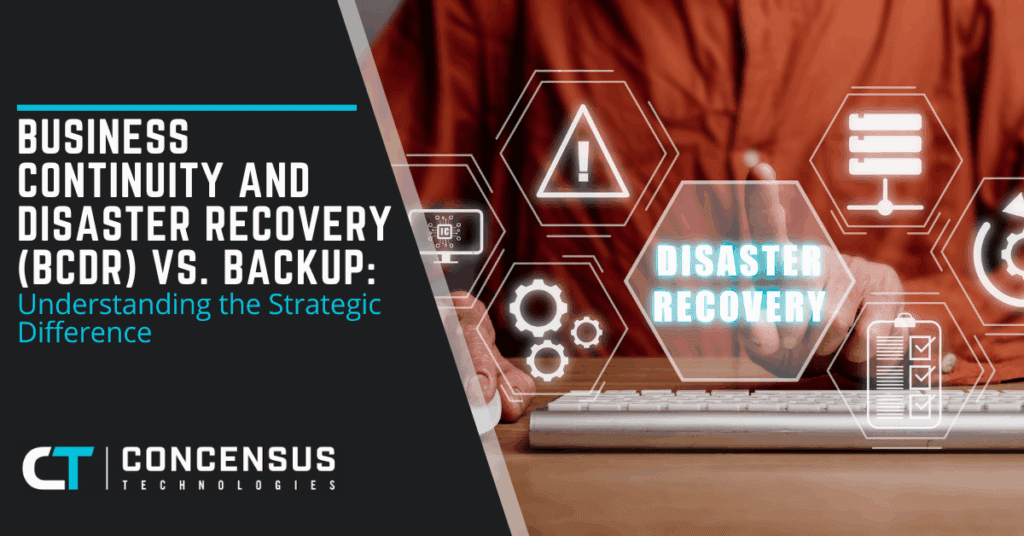
System downtime impacts more than just daily operations. It doesn’t matter if it was caused by human error, natural disasters, or equipment failures. When systems go offline, it can cause operational, financial, and reputational damage. Properly protecting data is critical to minimizing system downtime.
Certainly, data backups are a critical part of any data protection strategy, but they are only a small part of organizational continuity. That is why Business Continuity and Disaster Recovery (BCDR) is essential. Concensus Technologies helps companies design and implement effective BCDR plans.
It’s important to understand the differences between simple data backups and BCDR. Simple backups are not sufficient to ensure continuity. Understanding the differences can help your entire business, and not just its data, recover more effectively during disruptions.
The Limits of Traditional Backups
Backups are critical for preserving data, but they don’t keep your business running when disaster strikes. A backup copies data from production systems to a secure location. The backed-up data can then be restored if it is corrupted or lost. While it is a critical part of data protection, it does nothing to address business operations.
Backup Benefits:
- Preserve databases, system images, and files
- Restore data when it’s corrupted, deleted, or compromised
Backup Limitations:
- No automatic failover
- No application recovery options
- No response coordination
Risks of Relying Solely on Backups
While an integral part of data protection, solely relying on backups for a disaster recovery plan leaves organizations open to the following:
- Extended downtime because systems are rebuilt manually.
- No workflows for applications and services.
- No predefined recovery time (RTO) or recovery point targets (RPO).
- Business operations can’t function normally even if data is restored.
Backup solutions are important, but they are considered passive. They restore data, but they don’t rebuild infrastructure or get your business running again.
The Resilience of BCDR
While backups are a component of BCDR, it is much more than that. BCDR is a framework providing guidance to aid continuity. It considers processes, technology, and people to maintain operational capabilities in a coordinated effort.
Key functions of a BCDR Strategy:
- Operational continuity: Ensures services are available or can be restored quickly.
- Data restoration: Retrieves critical data from backups and recovers applications.
- Response coordination: Provides communication protocols across departments.
- Failover for infrastructure: Allows for quick transition to alternate platforms while recovery occurs.
- Process-driven recovery: Prioritizes key organizational activities and adheres to agreed-upon timelines.
Where backups are passive, BCDR is active. It helps transform your business into a resilient organization that can minimize downtime.
Backups as Part of BCDR
Backups and BCDR shouldn’t be viewed as alternatives to each other. They should be viewed as complementary. Backups feed into a BCDR plan, but on their own they aren’t enough.
Best practices for integrating backups into BCDR include:
- Backup system testing under recovery conditions
- Automating application recovery
- Implementing infrastructure failover contingencies
- Developing role-based responses for coordinated action
- Updating BCDR periodically to ensure effectiveness
Components of a Comprehensive BCDR Plan
A comprehensive BCDR plan combines technology, processes, and people. Key elements include:
Reliable and Tested Backups
Having a backup system installed within the digital framework of your organization is only as effective as its ability to restore data quickly and seamlessly. Backups need to ensure they work correctly:
- Routinely audited
- Simulated under recovery scenarios
- Monitored to ensure backup integrity
System and Application-Level Recovery
Restoration of data is important, but without applications to use it, data is useless. BCDR plans should incorporate:
- Processes to rebuild virtual machines
- Flexible network reconfiguration
- Methods to quickly reconnect frontend applications to back-end databases
- Verification of application dependencies
Infrastructure Failover Capabilities
Redundancy within any IT environment is key to maintaining its functionality. Whether cloud-based or within virtualized environments, failover solutions are an absolute necessity.
A BCDR plan needs to include:
- Defined failover environments
- Automated switchover solutions
- Redirection DNS strategies
- Critical service uptime validation
Defined Response Procedures
In a crisis, clarity in responsibilities is essential. BCDR plans should specify:
- Incident response team members
- Escalation protocols
- Communication channels (internal and external)
- Compliance and regulatory reporting workflows
Updating BCDR
It is worth noting that BCDR planning is not static. Disruptions continue to evolve at an alarming rate. This is why periodic testing and updates need to occur to ensure the BCDR is accurate and effective.
- Annual or biannual disaster simulations
- Post-incident reviews
- Update BCDR following any business or technology updates
Protecting More Than Data
Backups are insufficient on their own to protect business continuity. A well-designed BCDR plan provides the structure your business needs to recover quickly and keep operating.
Organizations with comprehensive BCDR plans recover faster, minimize downtime, and maintain customer trust.
Build a Tailored BCDR Plan
If your disaster recovery plan ends with “we have backups,” it’s time to reconsider. Protecting your business is more than just backing up information, it means planning for your entire operation.
Whether you’re creating a new BCDR strategy or improving an existing one, Concensus Technologies can help. We combine professional expertise with a personal touch to make the process straightforward.
We offer a no-obligation consultation with our resilience specialists. Let us help you build a BCDR strategy that protects your applications, systems, and data, and keeps your business moving forward.
Let us give you peace of mind
Leave it to our experts to keep your organization secure around the clock. Partner with us for trusted technology support.
